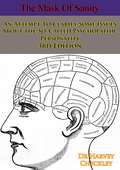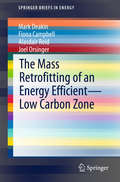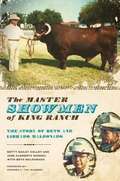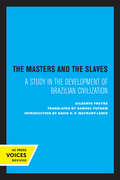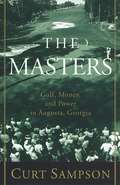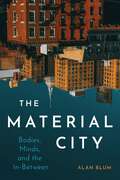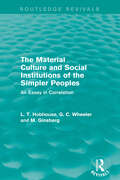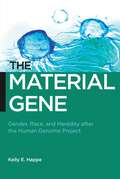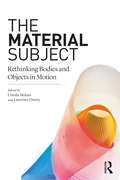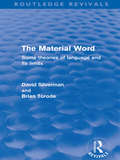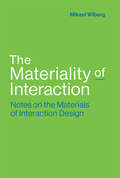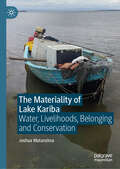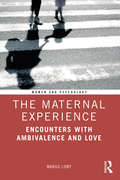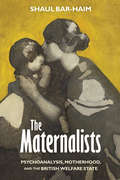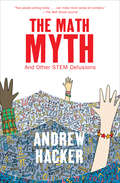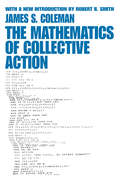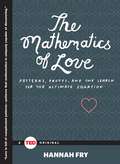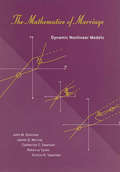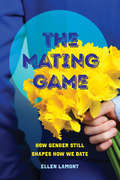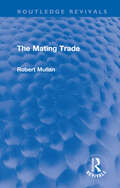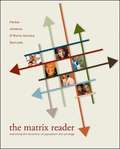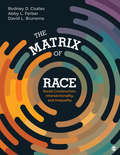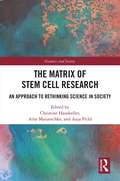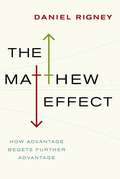- Table View
- List View
The Mask Of Sanity: An Attempt To Clarify Some Issues About the So-Called Psychopathic Personality 3rd Edition
by Dr Hervey M. CleckleyOriginally published in 1941 under the title Mask of Sanity: An Attempt to Clarify Some Issues About the So-Called Psychopathic Personality, this influential book became a landmark in psychiatric case studies and was repeatedly revised, expanded and reprinted in subsequent editions--here we present the 3rd edition published in 1955.The Mask of Sanity is distinguished by its central thesis that the psychopath exhibits normal function according to standard psychiatric criteria, yet privately engages in destructive behavior. The book was intended to assist with detection and diagnosis of the elusive psychopath for purposes of palliation and offered no cure for the condition itself. The idea of a master deceiver secretly possessed of no moral or ethical restraints, yet behaving in public with excellent function, electrified American society and led to heightened interest in both psychological introspection and the detection of hidden psychopaths in society at large, leading to a refinement of the word itself into what was perceived to be a less stigmatizing term, "sociopath".
The Mass Retrofitting of an Energy Efficient--Low Carbon Zone
by Mark Deakin Fiona Campbell Alasdair Reid Joel OrsingerMaximizing reader insights into the strategic value of mass retrofits in the residential property sector through a detailed case study analysis of the 'Hackbridge project', this book uses this development to broaden understanding of how planners may perform urban regeneration in accordance with a centralized plan. This book demonstrates how urban morphology matters, not only with respect to either the geometry of design and construction systems, or occupational behaviours, but with regards to the potential with which the planning, (re)development, design, construction, use and occupation of buildings, has to not only lower levels of energy consumption and rates of carbon emission, but also to reduce global warming associated with climate change. Delivering a critique of the state-of-the-art on urban morphology, the geometry of design typologies, construction systems and occupational behaviours and armed with the critical insights this offers, this book offers a context-specific analysis of how institutions can begin to actively plan for, integrate and sustain the development of energy efficient-low carbon zones.
The Master Showmen of King Ranch
by Stephen J. "Tio" KlebergTexas's King Ranch has become legendary for a long list of innovations, the most enduring of which is the development of the first official cattle breed in the Americas, the Santa Gertrudis. Among those who played a crucial role in the breed's success were Librado and Alberto "Beto" Maldonado, master showmen of the King Ranch. A true "bull whisperer," Librado Maldonado developed a method for gentling and training cattle that allowed him and his son Beto to show the Santa Gertrudis to their best advantage at venues ranging from the famous King Ranch auctions to a Chicago television studio to the Dallas-Fort Worth airport. They even boarded a plane with the cattle en route to the International Fair in Casablanca, Morocco, where they introduced the Santa Gertrudis to the African continent. In The Master Showmen of King Ranch, Beto Maldonado recalls an eventful life of training and showing King Ranch Santa Gertrudis. He engagingly describes the process of teaching two-thousand-pound bulls to behave "like gentlemen" in the show ring, as well as the significant logistical challenges of transporting them to various high-profile venues around the world. His reminiscences, which span more than seventy years of King Ranch history, combine with quotes from other Maldonado family members, co-workers, and ranch owners to shed light on many aspects of ranch life, including day-to-day work routines, family relations, women's roles, annual celebrations, and the enduring ties between King Ranch owners and the vaquero families who worked on the ranch through several generations.
The Masters and the Slaves: A Study in the Development of Brazilian Civilization
by Gilberto FreyreThis title is part of UC Press's Voices Revived program, which commemorates University of California Press’s mission to seek out and cultivate the brightest minds and give them voice, reach, and impact. Drawing on a backlist dating to 1893, Voices Revived makes high-quality, peer-reviewed scholarship accessible once again using print-on-demand technology. This title was originally published in 1986.
The Masters: Golf, Money, and Power in Augusta, Georgia
by Curt SampsonThe Masters golf tournament weaves a hypnotic spell. It is the toughest ticket in sports, with black-market tickets selling for $10,000 and more. Success at Augusta National breeds legends, while failure can overshadow even the most brilliant of careers. But as Curt Sampson, author of the bestselling Hogan, reveals in The Masters, a cold heart beats behind the warm antebellum façade of this famous Augusta course. And that heart belongs to the man who killed himself on the grounds two decades ago. Club and tournament founder Clifford Roberts, a New York stockbroker, still seems to run the place from his grave. An elusive and reclusive figure, Roberts pulled the strings that made the Masters the greatest golf tournament in the world. His story--including his relationship with presidents, power brokers, and every golf champion from Bobby Jones to Arnold Palmer to Jack Nicklaus--has never been told. Until now. The Masters is an amazing slice of history, taking us inside the presidency of Dwight D. Eisenhower, Augusta's most famous member. It is a look at how the new South coexists with the old South: the relationships between blacks and whites, between Southerners and Northerners, between rich and poor--with such characters as James Brown, the Godfather of Soul; the great boxer Beau Jack; and Frank Stranahan, the playboy golfer and the only white pro ever banned from the tournament. The Masters is a spellbinding portrait of a tournament unlike any other.
The Material City: Bodies, Minds, and the In-Between (Culture of Cities Series)
by Alan BlumRedirecting examinations of the culture of the city away from its customs, art, and amenities to focus on the mental life of modern society, Alan Blum explores the methods cities and their subjects use to find meaning in the context of urban life, in particular the city’s relationships to social change and what has traditionally been identified as justice.The Material City pictures the city as a landscape of diverse clashes over beliefs, a site that exhibits interpretive collisions over globalization, gentrification, innovation, preservation, market value, popular culture, crowds, consumption, urban governance, and different strategies for healing the democratic city’s ever-present conflicts over these concerns. Each chapter uses a problem of urban life to observe and analyze assumptions and values that are typically taken for granted and unspoken, using elements of the philosophy of Plato as well as the work of modern thinkers such as Georg Simmel, Gertrude Stein, Ludwig Wittgenstein, Virginia Woolf, Hannah Arendt, and Jacques Lacan.The Material City translates contested views of everyday life and its management into a deeper reflection on urbanity as a system of desire. The historical and the contemporary metropolis alike are shown to be sites where the enigma of mortality – and its relation to pleasure, comedy, and fate – plays out.
The Material Culture and Social Institutions of the Simpler Peoples: An Essay in Correlation (Routledge Revivals)
by L. T. Hobhouse G. C. Wheeler M GinsbergOriginally published in 1915, this pioneer study has long occupied an important place in the literature of sociology. An exercise in the statistical correlation of the economic and social institutions of the working classes of the early twentieth century, the book is an important link between contemporary sociology, with a focus on the problems of social development, and the classical social liberalism on which L. T. Hobhouse left his mark. The reissue includes the introduction written by Morris Ginsberg in the 1965 reprint, where he explains what he and his colleagues set out to achieve and responds to the criticism faced by the study. This is a classic work which is still of great value to sociologists and anthropologists today.
The Material Gene: Gender, Race, and Heredity after the Human Genome Project (Biopolitics #9)
by Kelly E. HappeWinner of the 2014 Diamond Anniversary Book AwardFinalist for the 2014 National Communications Association Critical and Cultural Studies Division Book of the Year AwardIn 2000, the National Human Genome Research Institute announced the completion of a “draft” of the human genome, the sequence information of nearly all 3 billion base pairs of DNA. Since then, interest in the hereditary basis of disease has increased considerably. In The Material Gene, Kelly E. Happe considers the broad implications of this development by treating “heredity” as both a scientific and political concept. Beginning with the argument that eugenics was an ideological project that recast the problems of industrialization as pathologies of gender, race, and class, the book traces the legacy of this ideology in contemporary practices of genomics. Delving into the discrete and often obscure epistemologies and discursive practices of genomic scientists, Happe maps the ways in which the hereditarian body, one that is also normatively gendered and racialized, is the new site whereby economic injustice, environmental pollution, racism, and sexism are implicitly reinterpreted as pathologies of genes and by extension, the bodies they inhabit. Comparing genomic approaches to medicine and public health with discourses of epidemiology, social movements, and humanistic theories of the body and society, The Material Gene reworks our common assumption of what might count as effective, just, and socially transformative notions of health and disease.
The Material Subject: Rethinking Bodies and Objects in Motion
by Laurence Douny Urmila MohanThe Material Subject emphasises how bodily and material cultures combine to make and transform subjects dynamically. The book is based on the French Matière à Penser (MaP) school of thought, which draws upon the ideas of Mauss, Schilder, Foucault and Bourdieu, among others, to enhance the anthropological study of embodiment, practices, techniques, materiality and power. Through theoretical sophistication and empirical field research, case studies from Europe, Africa and Asia bring MaP’s ideas into dialogue with other strands of material culture studies in the English-speaking world. These studies mediate different scales of engagement through a sensori-motor, affective and cognitive focus on practices of making and doing. Examples range from the precarity of professional divers in French public works to the gendered subjectivity of female carpet weavers in Morocco, from the ways Swiss watchmakers transmit craft knowledge to how Hindu devotees in India make efficacious use of altars, and from the enskilment of Paiwan indigenous people in Taiwan to the prestige of women’s wild silk wrappers in Burkina Faso. The chapters are organised according to domains of practice, defined as 'matter of' work and technology, heritage, politics, religion and knowledge. Scholars and students with an interest in material culture will gain valuable access to global research, rooted in a specific intellectual tradition.
The Material Word: Some theories of language and its limits (Routledge Revivals)
by David Silverman Brian TorodeFirst published in 1980, this reissue is a study of the sociology of language, which aims to bridge the gap between textbook and monograph by alternating chapters of explication and analysis. A chapter outlining a particular theory and suggesting general criticisms is followed by a chapter offering an original application of that theory. The aim of the authors is to treat text and talk as the site of specific practices which sustain or subvert particular relations between appearance and reality.
The Materiality of Interaction: Notes on the Materials of Interaction Design (The\mit Press Ser.)
by Mikael WibergA new approach to interaction design that moves beyond representation and metaphor to focus on the material manifestations of interaction.Smart watches, smart cars, the Internet of things, 3D printing: all signal a trend toward combining digital and analog materials in design. Interaction with these new hybrid forms is increasingly mediated through physical materials, and therefore interaction design is increasingly a material concern. In this book, Mikael Wiberg describes the shift in interaction design toward material interactions. He argues that the “material turn” in human-computer interaction has moved beyond a representation-driven paradigm, and he proposes “material-centered interaction design” as a new approach to interaction design and its materials. He calls for interaction design to abandon its narrow focus on what the computer can do and embrace a broader view of interaction design as a practice of imagining and designing interaction through material manifestations. A material-centered approach to interaction design enables a fundamental design method for working across digital, physical, and even immaterial materials in interaction design projects.Wiberg looks at the history of material configurations in computing and traces the shift from metaphors in the design of graphical user interfaces to materiality in tangible user interfaces. He examines interaction through a material lens; suggests a new method and foundation for interaction design that accepts the digital as a design material and focuses on interaction itself as the form being designed; considers design across substrates; introduces the idea of “interactive compositions”; and argues that the focus on materiality transcends any distinction between the physical and digital.
The Materiality of Lake Kariba: Water, Livelihoods, Belonging and Conservation
by Joshua MatanzimaThis book is an exploration of one of the world’s largest man-made reservoirs, Lake Kariba, created along the Zambezi River in central Africa. Originally built for electricity generation, as the lake reached its full capacity in 1963 it attracted other socioeconomic activities such as tourism, recreation, fisheries, and conservation. The material properties of the waterscape (including waves, strong winds, water volumes, deities and aquatic species) have shaped these socioeconomic activities since its creation. Community interpretations of the reservoir feature stories of fear, death, income generation, livelihoods, illegal cross-border trade, religion and everyday conflicts with wild animals. Drawing on extended ethnographic research and the author’s personal experience growing up around Lake Kariba, this empirically-rich book provides a nuanced discussion of the ways in which the waterscape shapes people’s lives and livelihoods. Additionally, the book explores the challenges ofsustaining and preserving Lake Kariba's unique ecosystem amidst environmental pressures and competing demands for resources. Readers will gain a nuanced perspective of the significance of the lake, its relationship with neighboring communities, and its evolution over time.
The Maternal Experience: Encounters with Ambivalence and Love (Women and Psychology)
by Margo LowyThe Maternal Experience explores the powerful and dynamic nature of maternal ambivalence and disrupts the conventional narrative of the mother’s lived experience by arguing that encounters with feelings of hatred are both universal and have the capacity to stimulate and enrich her maternal love. The book draws on the author’s personal mothering experiences, those of other women, and examples from film to inspire new introspection about the everyday maternal experience. Lowy takes a psychosocial approach to weave thinking from selected psychoanalytic and contemporary accounts together with personal stories to explore how maternal ambivalence operates, and how mothering is sourced in psychic struggles between loving and hating feelings in an atmosphere that is rife with social and personal expectations and prohibitions. By reworking the experience of maternal ambivalence, the book secures an understanding of the mother’s feelings of hatred as a catalyst for her love and allows these maligned and taboo emotions to be named and reframed into acceptable and transformative feelings. Brought alive by examples from film and first-hand experience, this book is fascinating reading for academics and students of psychology, maternal and women’s studies, and sociology, as well as practitioners in the fields of psychology, social work, medicine and counselling.
The Maternalists: Psychoanalysis, Motherhood, and the British Welfare State (Intellectual History of the Modern Age)
by Shaul Bar-HaimThe Maternalists is a study of the hitherto unexplored significance of utopian visions of the state as a maternal entity in mid-twentieth century Britain. Demonstrating the affinities between welfarism, maternalism, and psychoanalysis, Shaul Bar-Haim suggests a new reading of the British welfare state as a political project.After the First World War, British doctors, social thinkers, educators, and policy makers became increasingly interested in the contemporary turn being made in psychoanalytic theory toward the role of motherhood in child development. These public figures used new notions of the "maternal" to criticize modern European culture, and especially its patriarchal domestic structure. This strand of thought was pioneered by figures who were well placed to disseminate their ideas into the higher echelons of British culture, education, and medical care. Figures such as the anthropologists Bronislaw Malinowski and Geza Róheim, and the psychiatrist Ian Suttie—to mention only a few of the "maternalists" discussed in the book—used psychoanalytic vocabulary to promote both imagined perceptions of motherhood and their idea of the "real" essence of the "maternal." In the 1930s, as European fascism took hold, the "maternal" became a cultural discourse of both collective social anxieties and fantasies, as well as a central concept in many strands of radical, and even utopian, political thinking. During the Second World War, and even more so in the postwar era, psychoanalysts such as D. W. Winnicott and Michael Balint responded to the horrors of the war by drawing on interwar maternalistic thought, making a demand to "maternalize" British society, and providing postwar Britain with a new political idiom for defining the welfare state as a project of collective care.
The Math Myth: And Other STEM Delusions
by Andrew HackerA New York Times–bestselling author looks at mathematics education in America—when it&’s worthwhile, and when it&’s not. Why do we inflict a full menu of mathematics—algebra, geometry, trigonometry, even calculus—on all young Americans, regardless of their interests or aptitudes? While Andrew Hacker has been a professor of mathematics himself, and extols the glories of the subject, he also questions some widely held assumptions in this thought-provoking and practical-minded book. Does advanced math really broaden our minds? Is mastery of azimuths and asymptotes needed for success in most jobs? Should the entire Common Core syllabus be required of every student? Hacker worries that our nation&’s current frenzied emphasis on STEM is diverting attention from other pursuits and even subverting the spirit of the country. Here, he shows how mandating math for everyone prevents other talents from being developed and acts as an irrational barrier to graduation and careers. He proposes alternatives, including teaching facility with figures, quantitative reasoning, and understanding statistics. Expanding upon the author&’s viral New York Times op-ed, The Math Myth is sure to spark a heated and needed national conversation—not just about mathematics but about the kind of people and society we want to be. &“Hacker&’s accessible arguments offer plenty to think about and should serve as a clarion call to students, parents, and educators who decry the one-size-fits-all approach to schooling.&” —Publishers Weekly, starred review
The Mathematics of Collective Action
by James ColemanPhilosophers, social scientists, and laymen have used two perspectives in analyzing social action. One sees man's action as the result of causal forces, and the other sees action as purposive and goal directed. Mathematical treatment of social action has shown this same dichotomy. Some models of behavior describe a causal process, in which there is no place for intention or purpose. Most stochastic models of behavior, whether individual or group, are like this. Another body of work, however, employs purpose, anticipation of some future state, and action designed to maximize the proximity to some goal. Classical microeconomic theory, statistical decision theory, and game theory exemplify this direction.This book examines these two directions of work, and makes original contributions to the second. An introductory chapter outlines these two bodies of work, and casts them in a common frame, to display their similarities and differences. Chapter 2 reviews at length recent work in stochastic processes that makes up the first body of work, which sees social action as the resultant of causal forces. The remaining chapters develop a mathematical framework for the study of systems of social action using a purposive theoretical base. These chapters are designed particularly to contribute to the study of collective decisions, a form of social action that has proved particularly challenging to theoretical analysis. First published in 1973, this became a significant work both in problem solving and in the future career of the author. It is of continuing importance to researchers and students interested in statistical analysis.
The Mathematics of Love: Patterns, Proofs, and the Search for the Ultimate Equation (TED Books)
by Hannah FryIn this must-have for anyone who wants to better understand their love life, a mathematician pulls back the curtain and reveals the hidden patterns—from dating sites to divorce, sex to marriage—behind the rituals of love.The roller coaster of romance is hard to quantify; defining how lovers might feel from a set of simple equations is impossible. But that doesn’t mean that mathematics isn’t a crucial tool for understanding love. Love, like most things in life, is full of patterns. And mathematics is ultimately the study of patterns—from predicting the weather to the fluctuations of the stock market, the movement of planets or the growth of cities. These patterns twist and turn and warp and evolve just as the rituals of love do. In The Mathematics of Love, Dr. Hannah Fry takes the reader on a fascinating journey through the patterns that define our love lives, applying mathematical formulas to the most common yet complex questions pertaining to love: What’s the chance of finding love? What’s the probability that it will last? How do online dating algorithms work, exactly? Can game theory help us decide who to approach in a bar? At what point in your dating life should you settle down? From evaluating the best strategies for online dating to defining the nebulous concept of beauty, Dr. Fry proves—with great insight, wit, and fun—that math is a surprisingly useful tool to negotiate the complicated, often baffling, sometimes infuriating, always interesting, mysteries of love.
The Mathematics of Marriage: Dynamic Nonlinear Models
by John M. Gottman James D. Murray Catherine C. Swanson Rebecca Tyson Kristin R. SwansonDivorce rates are at an all-time high. But without a theoretical understanding of the processes related to marital stability and dissolution, it is difficult to design and evaluate new marriage interventions. The Mathematics of Marriage provides the foundation for a scientific theory of marital relations. The book does not rely on metaphors, but develops and applies a mathematical model using difference equations. The work is the fulfillment of the goal to build a mathematical framework for the general system theory of families first suggested by Ludwig Von Bertalanffy in the 1960s. The book also presents a complete introduction to the mathematics involved in theory building and testing, and details the development of experiments and models. In one "marriage experiment," for example, the authors explored the effects of lowering or raising a couple's heart rates. Armed with their mathematical model, they were able to do real experiments to determine which processes were affected by their interventions. Applying ideas such as phase space, null clines, influence functions, inertia, and uninfluenced and influenced stable steady states (attractors), the authors show how other researchers can use the methods to weigh their own data with positive and negative weights. While the focus is on modeling marriage, the techniques can be applied to other types of psychological phenomena as well.
The Mating Game: How Gender Still Shapes How We Date
by Ellen LamontDespite enormous changes in patterns of dating and courtship in twenty-first-century America, contemporary understandings of romance and intimacy remain firmly rooted in age-old assumptions of gender difference. These tenacious beliefs now vie with cultural messages of gender equality that stress independence, self-development, and egalitarian practices in public and private life.Through interviews with heterosexual and LGBTQ individuals, Ellen Lamont’s The Mating Game explores how people with diverse sexualities and gender identities date, form romantic relationships, and make decisions about future commitments as they negotiate uncertain terrain fraught with competing messages about gender, sexuality, and intimacy.
The Mating Trade (Routledge Revivals)
by Robert MullanAre marriages made in heaven? In reality many people need a little help in the arrangement of such matters, whether from Jewish shadkhans (matchmakers), go-betweens, computer or video-dating agencies, marriage bureaux, Asian arranged marriages, gay dating agencies or personal ads. Originally published in 1984, the author’s clear-sighted look at the mating trade takes some of the mystique away from the subject and is the first serious and detailed account of the ‘third party’ in marriage. Dr Mullan looks at the ‘singles scene’ and the ‘arranged marriage’ historically and cross-culturally, and makes it clear that there is nothing necessarily odd or deviant about the mating trade. It is a business like any other, and as long as people continue to want ‘perfect partners’, marriage, permanent relationships, dates and sex, and while evolving social structures make such demands ever more difficult to meet, the business will thrive. It could even expand and grow, but the author believes that first it will have to clean up its act!
The Matrix Reader: Examining the Dynamics of Oppression and Privilege
by Abby L. Ferber Christina M. Jimenez Andrea O'Reilly Herrera Dena R. SamuelsWritten by four authors from different disciplinary backgrounds, this reader promotes a commitment to an intersectional approach to teaching race, class, gender and sexuality. Unlike most books of its kind, it highlights the duality of privilege and oppression and the effects that race, gender, and sexuality have on our lives. This reader includes poems, reflective literary prose, historical events and documents, images drawn from the media, contemporary statistics of inequalities, visual images, and tools that empower students to become agents for social change.
The Matrix of Race: Social Construction, Intersectionality, And Difference
by Abby L. Ferber David L. Brunsma Rodney D. CoatesThe Matrix of Race, for race and ethnic relations courses, is written by three leading scholars -- Rodney D. Coates, David L. Brunsma, and Abby L. Ferber -- and reflects a very contemporary way of looking at race, minorities, and intergroup relations. Older texts use a "categorical" approach and feature a series of chapters that examine one minority group at a time (African Americans, Latino/a Americans, Asian Americans, Native Americans, etc.). Newer texts designed within the last 5-10 years are more likely to be organized topically, discuss various racial and ethnic minorities within the context of these topics, and use the most current theories and perspectives in this field. The Matrix of Race is built around these core ideas: -Race is a both a social construction and a social institution -Race is intersectional--it is embedded within other statuses (such as gender, social class, sexuality) -Concepts of race change over time and as we move from one physical location to another -We are all active agents in upholding, reproducing, or resisting constructions of race.
The Matrix of Race: Social Construction, Intersectionality, and Inequality
by Abby L. Ferber Rodney D. Coates Dr David L. BrunsmaThe Matrix of Race, for race and ethnic relations courses, is written by three leading scholars -- Rodney D. Coates, David L. Brunsma, and Abby L. Ferber -- and reflects a very contemporary way of looking at race, minorities, and intergroup relations. Older texts use a "categorical" approach and feature a series of chapters that examine one minority group at a time (African Americans, Latino/a Americans, Asian Americans, Native Americans, etc.). Newer texts designed within the last 5-10 years are more likely to be organized topically, discuss various racial and ethnic minorities within the context of these topics, and use the most current theories and perspectives in this field. The Matrix of Race is built around these core ideas: -Race is a both a social construction and a social institution -Race is intersectional--it is embedded within other statuses (such as gender, social class, sexuality) -Concepts of race change over time and as we move from one physical location to another -We are all active agents in upholding, reproducing, or resisting constructions of race.
The Matrix of Stem Cell Research: An Approach to Rethinking Science in Society (Genetics and Society)
by Christine Hauskeller Arne Manzeschke Anja PichlStem cell research has been a problematic endeavour. For the past twenty years it has attracted moral controversies in both the public and the professional sphere. The research involves not only laboratories, clinics and people, but ethics, industries, jurisprudence, and markets. Today it contributes to the development of new therapies and affects increasingly many social arenas. The matrix approach introduced in this book offers a new understanding of this science in its relation to society. The contributions are multidisciplinary and intersectional, illustrating how agency and influence between science and society go both ways. Conceptually, this volume presents a situated and reflexive approach for philosophy and sociology of the life sciences. The practices that are part of stem cell research are dispersed, and the concepts that tie them together are tenuous; there are persistent problems with the validation of findings, and the ontology of the stem cell is elusive. The array of applications shapes a growing bioeconomy that is dependent on patient donations of tissues and embryos, consumers, and industrial support. In this volume it is argued that this research now denotes not a specific field but a flexible web of intersecting practices, discourses, and agencies. To capture significant parts of this complex reality, this book presents recent findings from researchers, who have studied in-depth aspects of this matrix of stem cell research. This volume presents state-of-the-art examinations from senior and junior scholars in disciplines from humanities and laboratory research to various social sciences, highlighting particular normative and epistemological intersections. The book will appeal to scholars as well as wider audiences interested in developments in life science and society interactions. The novel matrix approach and the accessible case studies make this an excellent resource for science and society courses.
The Matthew Effect: How Advantage Begets Further Advantage
by Daniel RigneyThe old saying does often seem to hold true: the rich get richer while the poor get poorer, creating a widening gap between those who have more and those who have less. The sociologist Robert K. Merton called this phenomenon the Matthew effect, named after a passage in the gospel of Matthew. Yet the more closely we examine the sociological effects of this principle, the more complicated the idea becomes. Initial advantage doesn't always lead to further advantage, and disadvantage doesn't necessarily translate into failure. Does this theory need to be revisited?Merton's arguments have significant implications for our conceptions of equality and justice, and they challenge our beliefs about culture, education, and public policy. His hypothesis has been examined across a variety of social arenas, including science, technology, politics, and schooling, to see if, in fact, advantage begets further advantage. Daniel Rigney is the first to evaluate Merton's theory of cumulative advantage extensively, considering both the conditions that uphold the Matthew effect and the circumstances that cause it to fail. He explores whether growing inequality is beyond human control or disparity is socially constructed and subject to change. Reexamining our core assumptions about society, Rigney causes us to rethink the sources of inequity.
